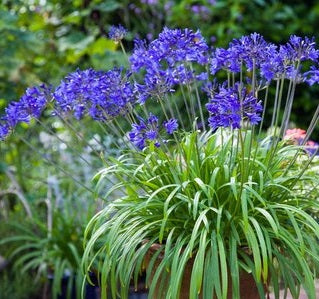Agapanthus Buddy Plant Kingdoms: Perfect Pairings for Your Garden
Understanding the Art of Agapanthus Treatment: Vital Steps for Healthy Development and Vibrant Blossoms
In the world of cultivation, the cultivation of agapanthus stands as a satisfying venture for those who seek to support these sophisticated blooming plants. With their striking flowers and elegant vegetation, agapanthus has actually caught the interest of garden enthusiasts worldwide. However, achieving optimal growth and lively blossoms calls for a nuanced technique that incorporates numerous essential actions. From picking the appropriate selection to understanding trimming techniques, the trip towards growing growing agapanthus plants is complex and holds the essential to unlocking the full possibility of these organic treasures.

Picking the Right Agapanthus Variety

When picking the right Agapanthus selection for your garden, consider aspects such as climate viability, flower shade, and growth behavior. Furthermore, take into consideration the climate in your area to make certain the Agapanthus variety you choose can grow in your details conditions. Recognizing the development behavior of various Agapanthus varieties is critical for appropriate placement within your garden.
Perfect Planting Conditions
Considering the optimum ecological needs is essential for successful Agapanthus cultivation. Agapanthus plants are sensitive to chilly temperature levels and ought to be protected from frost during winter months.
To guarantee healthy growth and vibrant blossoms, plant Agapanthus light bulbs at a deepness of regarding 2-4 inches and area them 8-12 inches apart. Mulching around the base of the plants assists maintain wetness and suppresses weed development.
Watering and Feeding Tips
Keeping proper dampness levels and providing necessary nutrients are essential aspects in the treatment program for Agapanthus plants. When it concerns sprinkling Agapanthus, it is important to strike a balance. These plants favor constantly moist dirt but are prone to root rot if overwatered. Throughout the growing season, water deeply when a week, making sure the soil is well-draining to avoid waterlogging. In hotter environments or during durations of dry spell, more regular watering might be essential to keep the soil equally moist. Nonetheless, decrease watering in the winter months to avoid water logged problems.
Feeding Agapanthus is essential for promoting healthy and balanced growth and respected flowers. Apply a well balanced fertilizer, such as a 10-10-10 formula, in the very early springtime as brand-new growth emerges. By adhering to these watering and feeding pointers, you can ensure your Agapanthus plants prosper and produce vibrant, long-lasting blossoms.
Trimming Techniques for Agapanthus
Pruning Agapanthus plants at the appropriate times and with correct techniques is essential for preserving their health and wellness and promoting optimum growth and flowering. The perfect time to prune Agapanthus remains in late winter or very early spring before new growth emerges. Begin by eliminating any dead or yellowing fallen leaves near the base of the plant. Cut them as close to the ground as feasible without damaging the arising shoots.
For flowered stems, wait until the blossoms have withered and afterwards cut them back to the base. This not only cleans up the plant's look yet likewise encourages the growth of brand-new flower buds. Deadheading invested flowers can additionally reroute the plant's energy right into creating even more blooms rather than establishing seeds. Nonetheless, straight from the source if you want to accumulate seeds for proliferation, leave some blossoms to completely dry and mature on the plant.
Keep in mind to make use of tidy, sharp devices to make recommended you read accurate cuts and decrease the danger of introducing illness. Agapanthus. Routine trimming will help keep your Agapanthus looking healthy and balanced and cool while making sure an abundant screen of beautiful flowers
Handling Usual Insects and Conditions
After ensuring proper pruning methods for Agapanthus, it is necessary to address common bugs and conditions that can impact the health and vitality of these plants. Agapanthus plants are typically sturdy but can still fall victim to certain concerns. One common parasite that influences Agapanthus is the Agapanthus gall midge. This small, orange fly lays its eggs in the foliage, resulting in altered growth and flower buds that fall short to open up. To battle this parasite, prune and ruin any affected plant parts and think about making use of insecticidal soap.
In addition, Agapanthus plants can suffer from root rot if they are planted in inadequately draining pipes dirt. By being watchful and taking timely activity against illness and insects, you can help your Agapanthus plants thrive and produce lively blossoms. Agapanthus.

Conclusion
Finally, grasping the art of agapanthus care involves selecting the right range, supplying suitable growing conditions, proper watering and fertilizing, appropriate trimming methods, and resolving typical parasites and diseases. By adhering to these important steps, you can guarantee healthy growth and vibrant blossoms for your agapanthus plants. Bear in mind to frequently keep track of and preserve your index plants to advertise their total health and durability.
To make sure healthy and balanced growth and lively blooms, plant Agapanthus light bulbs at a deepness of about 2-4 inches and space them 8-12 inches apart. By following these watering and fertilizing tips, you can guarantee your Agapanthus plants flourish and produce vibrant, long-lasting blossoms.
One typical pest that influences Agapanthus is the Agapanthus gall midget. In addition, Agapanthus plants can endure from root rot if they are planted in poorly draining dirt. By adhering to these essential steps, you can make certain healthy development and lively flowers for your agapanthus plants.